Survey of Applicable Methods for Determining Viscoelastic Effects in Ferroelectric and Antiferroelectric Chiral Liquid Crystals
Abstract
:1. Introduction
2. Timeline of Measurement Concepts
2.1. Motivation and Aim of the Study
2.2. Experimental Determination of Viscosity and Elasticity Coefficients
- (1)
- The value of the angle φ has to be determined from measurements of macroscopic quantities (such as refractive indices or electrical permittivity);
- (2)
- The equation of motion in the c-direction has to be solved, i.e., a well-defined distribution of the azimuthal angle φ on a microscopic scale.
2.3. Theoretical Background
3. Materials and Methods
- The spontaneous polarization of PS;
- The pitch p;
- Inclination angle θ;
- Linear electro-optical coefficient ;
- The relaxation time τ.
- The pitch was measured in homeotropically oriented samples using the following methods: spectroscopic [62,68,69,70] and the Cano method in a wedge sample [62,68] and in a homeotropically oriented free liquid crystal droplet [71]. The aforementioned methods give comparable results under the assumption that the refractive index of the common ray is 1.4.
- The tilt angle of the molecules was measured using the alternating field method. An electric field of rectangular shape with a fairly high frequency (from tens to hundreds of hertz) was used here. Light intensity was measured using a photodiode and observed on an oscilloscope.
- Changing the position of the optical axis causes a change in the intensity of light passing through the sample. The intensity of the light is recorded by a photodiode. At the output of the preamplifier, a signal proportional to the light intensity is obtained. The signal modulated in this way contains, in addition to a constant component, a variable component, called the electro-optical response. In addition, changes in the angle α can be simulated by rotating the microscope table along with the sample by a small angle αK [65,66]. In the work [69,70,71], an additional modification of this method was used. In the experiment, the constant component of the intensity of light passing through the sample was measured simultaneously with the variable component. During the measurement of the electro-optical response, the sample made oscillations with an amplitude of 0, 14°. The frequency of the oscillations was determined by the speed of rotation of the synchronous motor putting the system into motion and was 6.25 Hz. Calibration of the electro-optical response using the above-described system made it possible to obtain values of the light modulation depth in absolute units.
- Relaxation time was determined from measurements of the real and imaginary components of the electro-optical response as a function of frequency.
4. Results and Discussion
5. Conclusions
Funding
Data Availability Statement
Acknowledgments
Conflicts of Interest
References
- Lagerwall, S.T. Chirality, Symmetry and Physical Effects. In Chiral Liquid Crystals; Kuczyński, W., Ed.; IFM PAN: Poznań, Poland, 2005; pp. 185–222. [Google Scholar]
- Kitzerow, H.; Bahr, C. Chirality in Liquid Crystals; Springer Science & Business Media: Berlin/Heidelberg, Germany, 2001. [Google Scholar]
- Sluckin, T.J.; Dunmur, D.A.; Stegemeyer, H. Crystals That Flow: Classic Papers from the History of Liquid Crystals; Taylor & Francis: Abingdon, UK, 2004. [Google Scholar]
- Srivastava, A.K.; Chigrinov, V.G.; Kwok, H.S. Ferroelectric liquid crystals: Excellent tool for modern displays and photonics. J. Soc. Inf. Disp. 2015, 23, 253–272. [Google Scholar] [CrossRef]
- Pontus, J.; Dahlgren, A.; Komitov, L.; Matharu, A.S.; Grover, C.; Gouda, F.; Kutub, A. Optic, electrooptic and dielectric properties of novel antiferroelectric liquid crystal compounds. Ferroelectrics 2000, 244, 147–157. [Google Scholar] [CrossRef]
- Guo, Q.; Kexin, Y.; Chigrinov, V.; Zhao, H.; Tribelsky, M. Ferroelectric Liquid Crystals: Physics and Applications. Crystal 2019, 9, 470. [Google Scholar] [CrossRef]
- Chandani, A.D.I.; Górecka, E.; Ouchi, Y.; Takezoe, H.; Fukuda, A. Antiferroelectric Chiral Smectic Phases Responsible for the Trislable Switching in MHPOBC. Jpn. J. Appl. Phys. 1998, 28, L1265–L1268. [Google Scholar] [CrossRef]
- Fitas, J.; Marzec, M.; Szymkowiak, M.; Jaworska-Gołąb, T.; Deptuch, A.; Tykarska, M.; Kurp, K.; Urbańska, M.; Bubnov, A. Mesomorphic, electro-optic and structural properties of binary liquid crystalline mixtures with ferroelectric and antiferroelectric liquid crystalline behavior. Phase Transit. 2018, 91, 1017–1026. [Google Scholar] [CrossRef]
- Kuczyński, W. Electro-Optical Studies of Relaxation Processes in Chiral Smectic Liquid Crystals. In Relaxation Phenomena: Liquid Crystals, Magnetic Systems, Polymers, High-Tc Superconductors, Metalic Glasses; Haase, W., Wróbel, S., Eds.; Springer: Berlin/Heidelberg, Germany, 2003; pp. 422–444. [Google Scholar]
- Orihara, H.; Ishibashi, Y. Electro-Optic Effect and Third-Order Nonlinear Dielectric Response in Antiferroelectric Liquid Crystals. J. Phys. Soc. Jpn. 1995, 64, 3775–3786. [Google Scholar] [CrossRef]
- Dardas, D.; Kuczyński, W. Non-linear electrooptical effects in chiral liquid crystals. Opto-Electron. Rev. 2004, 12, 277–280. [Google Scholar]
- Dardas, D.; Kuczyński, W.; Hoffmann, J. Measurements of absolute values of electrooptic coefficients in a ferroelectric liquid crystal. Phase Transit. 2006, 79, 213–222. [Google Scholar] [CrossRef]
- Jeżewski, W.; Kuczyński, W.; Hoffmann, J.; Dardas, D. Comparison of dielectric and optical response of chevron ferroelectric liquid crystals. Opto-Electron. Rev. 2008, 16, 281–286. [Google Scholar] [CrossRef]
- Kuczyński, W.; Dardas, D.; Goc, F.; Dabrowski, R. Linear and quadratic electrooptic effects in antiferroelectric liquid crystals. Ferroelectrics 2000, 244, 191–199. [Google Scholar] [CrossRef]
- Lagerwall, S.T. Linear and Non-Linear Polar Effects in Liquid Crystals. Mol. Cryst. Liq. Cryst. 2011, 543, 769–813. [Google Scholar] [CrossRef]
- Buka, A.; Éber, N. (Eds.) Flexoelectricity in Liquid Crystals: Theory, Experiments and Applications; World Scientific: Singapore, 2012. [Google Scholar]
- Gurovich, E.V.; Kats, E.I.; Lebedev, V.V. Orientational phase transitions in liquid crystals. Critical dynamics. Zh. Eksp. Teor. Fiz 1991, 100, 891. [Google Scholar]
- Stewart, I.W. The Static and Dynamic Continuum Theory of Liquid Crystals; CRC Press: Boca Raton, FL, USA, 2004. [Google Scholar]
- Jakli, A.; Saupe, A. One- and Two Dimensional Fluids: Properties of Smectic, Lamellar and Columnar Liquid Crystals; CRC Press: Boca Raton, FL, USA, 2006. [Google Scholar]
- Sengupta, A. Liquid Crystal Theory. In Topological Microfluidics; Springer Theses; Springer: Berlin/Heidelberg, Germany, 2013. [Google Scholar]
- de Genes, P.G. The Physics of Liquid Crystals; Oxford University Press: Oxford, UK, 1974. [Google Scholar]
- Mięsowicz, M. The three coefficients of viscosity of anisotropic liquids. Nature 1946, 158, 27. [Google Scholar] [CrossRef] [PubMed]
- Gähwiller, C. Direct determination of the five independent viscosity coefficients of nematic liquid crystals. Mol. Cryst. Liq. Cryst. 1973, 20, 301–318. [Google Scholar] [CrossRef]
- Leslie, F.M.; Laverty, J.S.; Carlsson, T. Continuum theory for biaxial nematic liquid crystals. Q. J. Mech. Appl. Math. 1992, 45, 595–606. [Google Scholar] [CrossRef]
- Leslie, F.M.; Stewart, I.W.; Nakagawa, M. A continuum theory for smectic C liquid crystals. Mol. Cryst. Liq. Cryst. 1991, 198, 443–454. [Google Scholar] [CrossRef]
- Takezoe, H.; Kondo, K.; Miyasato, K.; Abe, S.; Tsuchiya, T.; Fukuda, A.; Kuze, E. On the methods of determining material constants in ferroelectric smectic C* liquid crystals. Ferroelectrics 1984, 58, 55. [Google Scholar] [CrossRef]
- Lagerwall, S.T. Ferroelectric and Antiferroelectric Liquid Crystals; Wiley-VCH: Weinheim, Germany, 1999. [Google Scholar]
- Lagerwall, J.P.F.; Giesselmann, F. Current topics in smectic liquid crystal research. Chem. Phys. Chem. 2006, 7, 20–45. [Google Scholar] [CrossRef] [PubMed]
- Dahl, I.; Lagerwall, S.T. Elastic and flexoelectric properties of chiral smectic-C phase and symmetry considerations on ferroelectric liquid-crystal cells. Ferroelectrics 1984, 58, 215. [Google Scholar] [CrossRef]
- Skarp, K. Rotational viscosities in ferroelectric smectic liquid crystals. Ferroelectrics 1988, 84, 119. [Google Scholar] [CrossRef]
- Larson, R.G. The Structure and Rheology of Complex Fluids; Oxford University Press: New York, USA, 1999. [Google Scholar]
- Orsay Liquid Crystal Group. Simplified elastic theory for smectics C. Solid State Commun. 1971, 9, 653. [Google Scholar] [CrossRef]
- Ericksen, J.L. Anisotropic fluids. Arch. Ration. Mech. Anal. 1960, 4, 231–237. [Google Scholar] [CrossRef]
- Parodi, O. Stress tensor for a nematic liquid crystal. J. Phys. 1970, 31, 581–584. [Google Scholar] [CrossRef]
- Handschy, M.A.; Clark, N.A. Structures and responses of ferroelectric liquid crystals in the surface-stabilized geometry. Ferroelectrics 1984, 59, 69–116. [Google Scholar] [CrossRef]
- Escher, C.; Geelhaar, T.; Böhm, E. Measurement of the rotational viscosity of ferroelectric liquid crystals based on a simple dynamical model. Liq. Cryst. 1988, 3, 469–484. [Google Scholar] [CrossRef]
- Piecek, W.; Rutkowska, J.; Kedzierski, J.; Perkowski, P.; Raszewski, Z.; Dabrowski, R.R. Liquid Crystals: Physics, Technology and Applications; SPIE: Bellingham, WA, USA, 1997; Volume 3318, pp. 148–153. [Google Scholar]
- Pierański, P.; Guyon, E.; Keller, P. Shear flow induced polarization in ferroelectric smectics C. J. Phys. 1975, 36, 1005. [Google Scholar] [CrossRef]
- Clark, N.A.; Lagerwali, S.T. Submicrosecond bistable electro-optic switching in liquid crystals. Appl. Phys. Lett. 1980, 36, 899. [Google Scholar] [CrossRef]
- Flatischler, K.; Skarp, K.; Lagerwall, S.T.; Stebler, B. Thin ferroelectric liquid crystal cells with surface-induced alignment: Optical characterization and electro-optic performance. Mol. Cryst. Liq. Cryst. 1985, 131, 21. [Google Scholar] [CrossRef]
- Dahl, I.; Lagerwall, S.T.; Skarp, K. Simple model for the polarization reversal current in a ferroelectric liquid crystal. Phys. Rev. A 1988, 36, 4380. [Google Scholar] [CrossRef]
- Geelhaar, T. Ferroelectric mixtures and their physico-chemical properties. Ferroelectrics 1988, 85, 329–349. [Google Scholar] [CrossRef]
- Kuczyński, W. Determination of elasticity and viscosity coefficients in a ferroelectric smectic c liquid crystal. Ber. Bunseeges. Phys. Chem. 1981, 85, 234. [Google Scholar] [CrossRef]
- Kuczyński, W.; Lagerwall, S.T.; Stebler, B. Determination of Elasticity and Viscosity Coefficients in a Chiral Smectic C Liquid Crystal. In Proceedings of the 11th Internationa Liquid Crystal Conference, Berkeley, CA, USA, 30 June–4 July 1986. [Google Scholar]
- Kawaida, M.; Akahane, T. Measurement of elastic constant and intrinsic twist of ferroelectric SmC* liquid crystal. Jap. J. Appl. Phys. 1990, 29, 340. [Google Scholar] [CrossRef]
- Ezcurra, A.; Jubindo, M.A.P.; De La Fuente, M.R.; Etxebarria, J.; Remon, A.; Tello, M.J. Dielectric and optical studies near the chiral-smectic-C–smectic-A transition of (s)-2-hydroxy-4-decyloxybenzylidene-4′-amino-2p″-methylbutylcinnamate. Liq. Cryst. 1989, 4, 125. [Google Scholar] [CrossRef]
- Gouda, F.; Skarp, K.; Andersson, G.; Kresse, H.; Lagerwall, S.T. Viscoelastic properties of the smectic A* and C* phases studied by a new dielectric method. Jap. J. Appl. Phys. 1989, 28, 1887. [Google Scholar] [CrossRef]
- Levstik, A.; Kutnjak, Z.; Levstik, J.; Zeks, B. Rotational viscosity in ferroelectric liquid crystal dobambc determined by dielectric method. Ferroelectrics 1990, 109, 267. [Google Scholar] [CrossRef]
- Adamow, A.; Sznitko, L.; Chrzumnicka, E.; Stachera, J.; Szukalski, A.; Martyński, T.; Myśliwiec, J. The ultra-photostable and electrically modulated Stimulated Emission in perylene-based dye doped liquid crystal. Sci. Rep. 2019, 9, 2143. [Google Scholar] [CrossRef] [PubMed]
- Shen, Y.; Dierking, I. Perspectives in Liquid-Crystal-Aided Nanotechnology and Nanoscience. Appl. Sci 2019, 9, 2512. [Google Scholar] [CrossRef]
- Hamley, I.W. Liquid Crystal Phase Formation by Biopolymers. Soft Matter 2010, 6, 1863–1871. [Google Scholar] [CrossRef]
- Tian, L.; Goodby, J.W.; Görtz, V.; Gleeson, H.F. The magnitude and temperature dependence of the Kerr constant in liquid crystal blue phases and the dark conglomerate phase. Liq. Cryst. 2013, 40, 1446. [Google Scholar] [CrossRef]
- Knapkiewicz, M.; Rachocki, A.; Bielejewski, M.; Sebastiao, P.J. NMR studies of molecular ordering and molecular dynamics in a chiral liquid crystal with the SmCα* phase. Phys. Rev. E 2020, 101, 52708. [Google Scholar] [CrossRef]
- Liang, H.H.; Xiao, Y.Z.; Hsh, F.J.; Wu, C.C.; Lee, J.Y. Enhancing the electro-optical properties of ferroelectric liquid crystals by doping ferroelectric nanoparticles. Liq. Cryst. 2010, 37, 255–261. [Google Scholar] [CrossRef]
- Ghosh, S.; Roy, S.K.; Acharya, S.; Chakrabarti, P.K.; Zurowska, M.; Dabrowski, R. Effect of multiferroic BiFeO3 nanoparticles on electro-optical and dielectric properties of a partially fluorinated orthoconic antiferroelectric liquid crystal mixture. EPL 2011, 96, 47003. [Google Scholar] [CrossRef]
- Resetic, A.; Milavec, J.; Domenici, V.; Zupancic, B.; Bubnov, A.; Zalar, B. Deuteron NMR investigation on orientational order parameter in polymer dispersed liquid crystal elastomers. Phys. Chem. Chem. Phys. 2020, 22, 23064–23072. [Google Scholar] [CrossRef] [PubMed]
- Khan, R.K.; Turlapati, S.; Rao, N.V.S.; Ghosh, S. Elastic and dielectric properties of ferroelectric nanoparticles/bent-core nematic liquid crystal blend. Eur. Phys. J. E 2017, 40, 75. [Google Scholar] [CrossRef] [PubMed]
- Singh, A.K.; Iqbal, A.; Singh, U.B.; Dabrowski, R.S.; Dhar, R. Thermodynamic, optical and switching parameters of a ferroelectric liquid crystalline material having SmA*-SmC*-SmBh* phase sequence. Phase Transit. 2018, 91, 811–820. [Google Scholar] [CrossRef]
- Zgueb, R.; Dhaouadi, H. Theoretical and experimental analysis of surface anchoring in the surface stabilization of ferroelectric liquid crystal cells. Capillarity 2024, 11, 31–40. [Google Scholar] [CrossRef]
- Lavrentovich, O.D. Splay-bend elastic inequalities shape tactoids, toroids, umbilics, and conic section walls in paraelectric, twist-bend, and ferroelectric nematics. Liq. Cryst. Rev. 2024, 12, 1–13. [Google Scholar] [CrossRef]
- Pierański, P.; Guyon, E.; Keller, P.; Liebert, L.; Kuczyński, W.; Pierański, P. Optical Study of a Chiral Smectic C Under Shear. Mol. Cryst. Liq. Cryst. 1977, 38, 275–301. [Google Scholar] [CrossRef]
- Kuczyński, W.; Nowicka, K.; Dardas, D.; Jeżewski, W.; Hoffmann, J. Determination of bulk values of twist elasticity coefficient in a chiral smectic C* liquid crystal. Opto-Electron. Rev. 2010, 18, 176–180. [Google Scholar] [CrossRef]
- Kuczyński, W.; Dardas, D.; Nowicka, K. Determination of the bulk rotational viscosity coefficient in a chiral smectic C* liquid crystal. Phase Transit. 2009, 82, 444–451. [Google Scholar] [CrossRef]
- Panarin, Y.P.; Kalinovskaya, O.; Vij, J.K. The investigation of the relaxation processes in antiferroelectric liquid crystals by broad band dielectric and electro-optic spectroscopy. Liq. Cryst. 1998, 25, 241–252. [Google Scholar] [CrossRef]
- Dardas, D.; Kuczyński, W.; Hoffmann, J.; Jeżewski, W.; Nowicka, K.; Małecki, J. Non-linear electrooptic effect in antiferroelectric liquid crystal. Opto-Electron. Rev. 2009, 17, 25–29. [Google Scholar] [CrossRef]
- Dardas, D.; Kuczyński, W.; Hoffmann, J.; Jeżewski, W. Determination of twist elastic constant in antiferroelectric liquid crystals. Meas. Sci. Technol. 2011, 22, 085707. [Google Scholar] [CrossRef]
- Diamant, H.; Drenck, K.; Pepinsky, R. Bridge for accurate measurement of ferroelectric hysteresis. Rev. Sci. Instrum. 1957, 28, 30. [Google Scholar] [CrossRef]
- Kuczyński, W.; Dardas, D.; Hoffmann, J.; Nowicka, K.; Jeżewski, W. Comparison of methods for determination of viscoelastic properties in chiral smectics C*. Phase Transit. 2012, 85, 358–363. [Google Scholar] [CrossRef]
- Dardas, D. Electro-optic and viscoelastic properties of a ferroelectric liquid crystalline binary mixture. Phase Transit. 2016, 89, 368–375. [Google Scholar] [CrossRef]
- Dardas, D. Tuning the electro-optic and viscoelastic properties of ferroelectric liquid crystalline materials. Rheol. Acta 2019, 58, 193–201. [Google Scholar] [CrossRef]
- Dardas, D.; Lalik, S.; Nowacka, Z.; Yevchenko, T.; Marzec, M. Electro-Optic Effect of Laser Photobleaching on Viscoelastic Properties of Chiral Liquid Crystals. Crystals 2023, 13, 164. [Google Scholar] [CrossRef]
- Yang, F.; Bradberry, G.W.; Sambles, J.R. Optical determination of the twist elastic constant of a smectic-C* liquid crystal. Phys. Rev. E 1996, 53, 674. [Google Scholar] [CrossRef]
- Rosenblatt, C.; Pindak, R.; Clark, N.A.; Meyer, R.B. Freely Suspended Ferroelectric Liquid-Crystal Films: Absolute Measurements of Polarization, Elastic Constants, and Viscosities. Phys. Rev. Lett. 1979, 42, 1220. [Google Scholar] [CrossRef]
- Sah, Y.; Suresh, K.A. Visco-elastic modes in some ferro-electric liquid crystals. Liq. Cryst. 1998, 24, 701. [Google Scholar] [CrossRef]
- Kuczyński, W. Behavior of the helix in some chiral smectic-C* liquid crystals. Phys. Rev. E 2010, 81, 021708. [Google Scholar] [CrossRef] [PubMed]
- Meyer, R.B. Ferroelectric Liquid Crystals; A Review. Mol. Cryst. Liq. Cryst. 1977, 40, 33. [Google Scholar] [CrossRef]
- Kumari, P.; Basnet, B.; Lavrentovich, M.O.; Lavrentovich, O.D. Chiral ground states of ferroelectric liquid crystals. Science 2024, 383, 1364–1368. [Google Scholar] [CrossRef] [PubMed]
- Stannarius, R. Liquid crystals: More than display fillings. Nat. Mater. 2009, 8, 617–618. [Google Scholar] [CrossRef] [PubMed]
- Kralj, N.; Ravnik, M.; Kos, Ž. Chirality, anisotropic viscosity and elastic anisotropy in three-dimensional active nematic turbulence. Commun. Phys. 2024, 7, 222. [Google Scholar] [CrossRef]
- INSTEC Inc. Available online: https://instec.com/portal/list/index/id/13.html (accessed on 26 May 2024).
- Emelyanenko, A.V.; Filimonova, E.S.; Khokhlov, A.R. Molecular origin of the heterogeneity in the nematic and smectic liquid crystals: Elastic constants, gradients of order parameters, and visualization of small objects. Phys. Rev. E 2021, 103, 022709. [Google Scholar] [CrossRef]
- Osiecka-Drewniak, N.; Drzewicz, A.; Juszyńska-Gałązka, E. Machine learning studies for liquid crystal texture recognition. Liq. Cryst. 2023, 51, 255–264. [Google Scholar] [CrossRef]

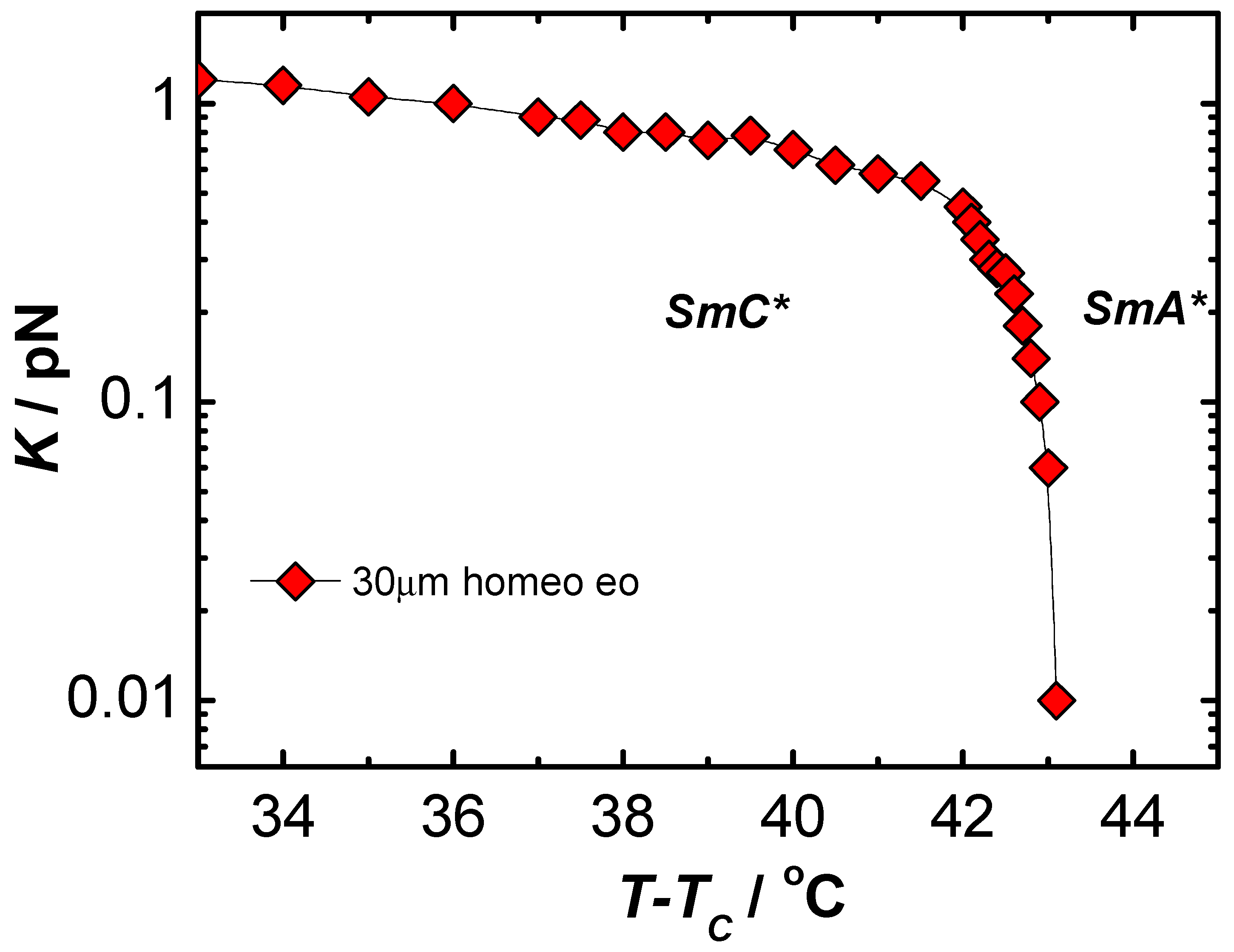
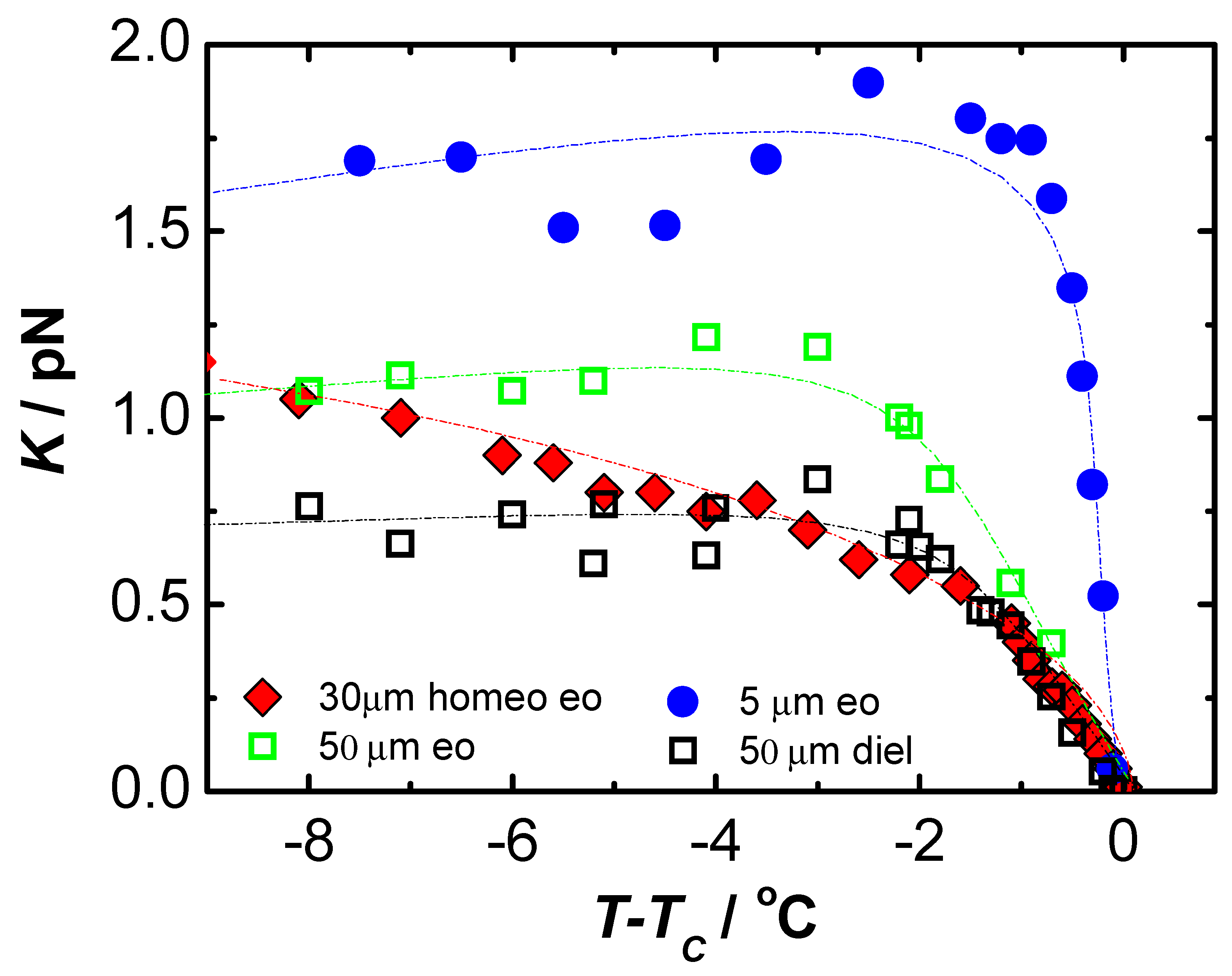
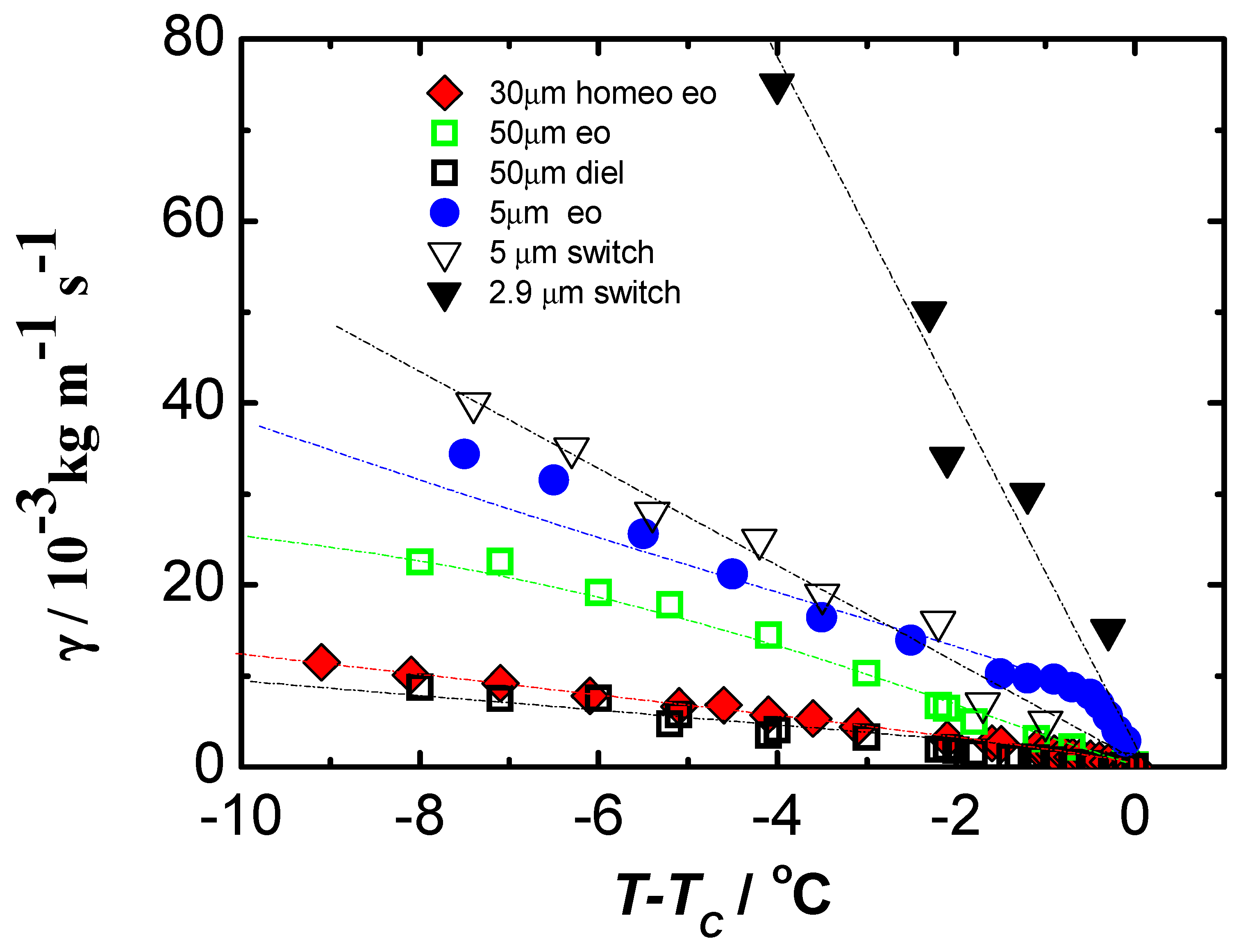

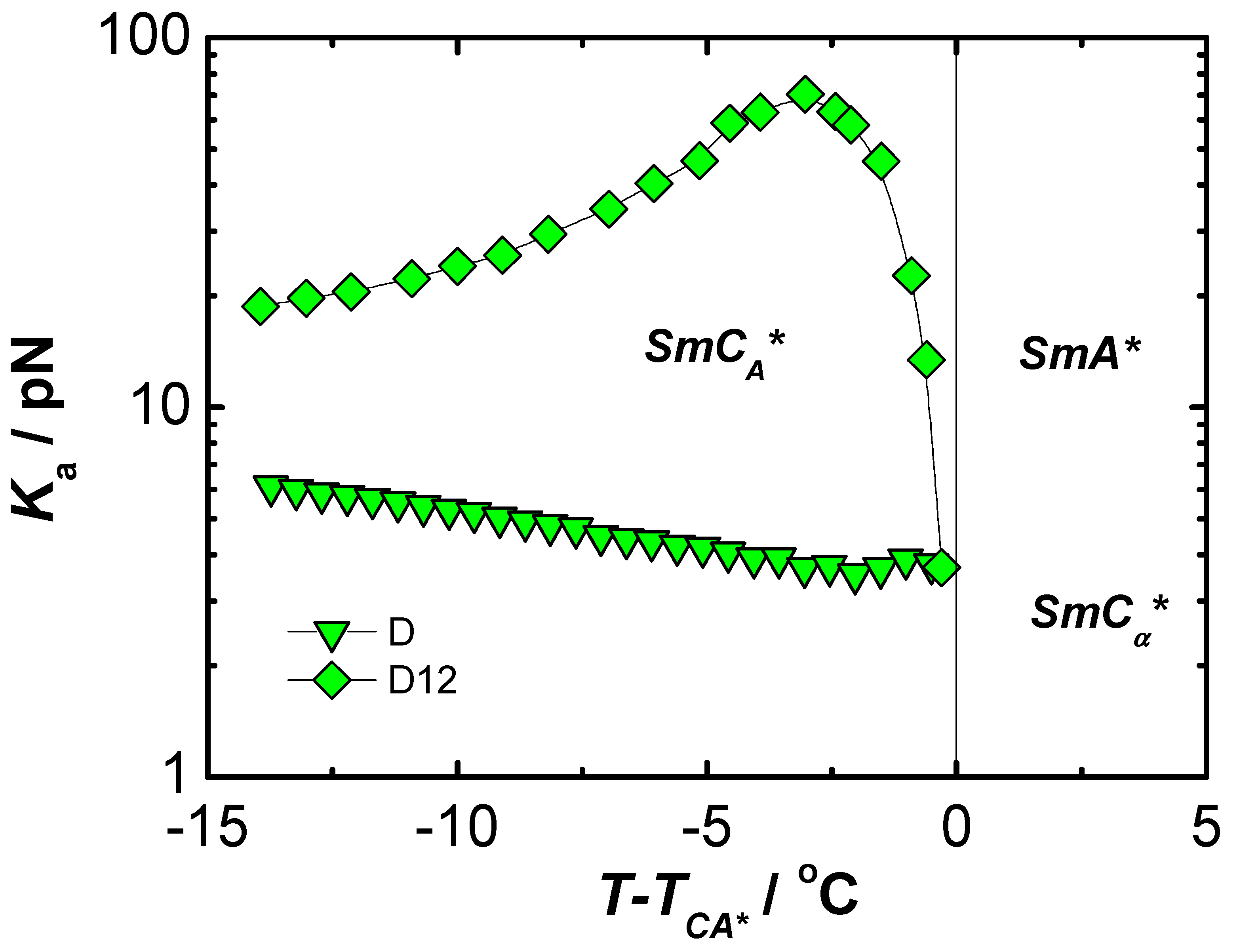
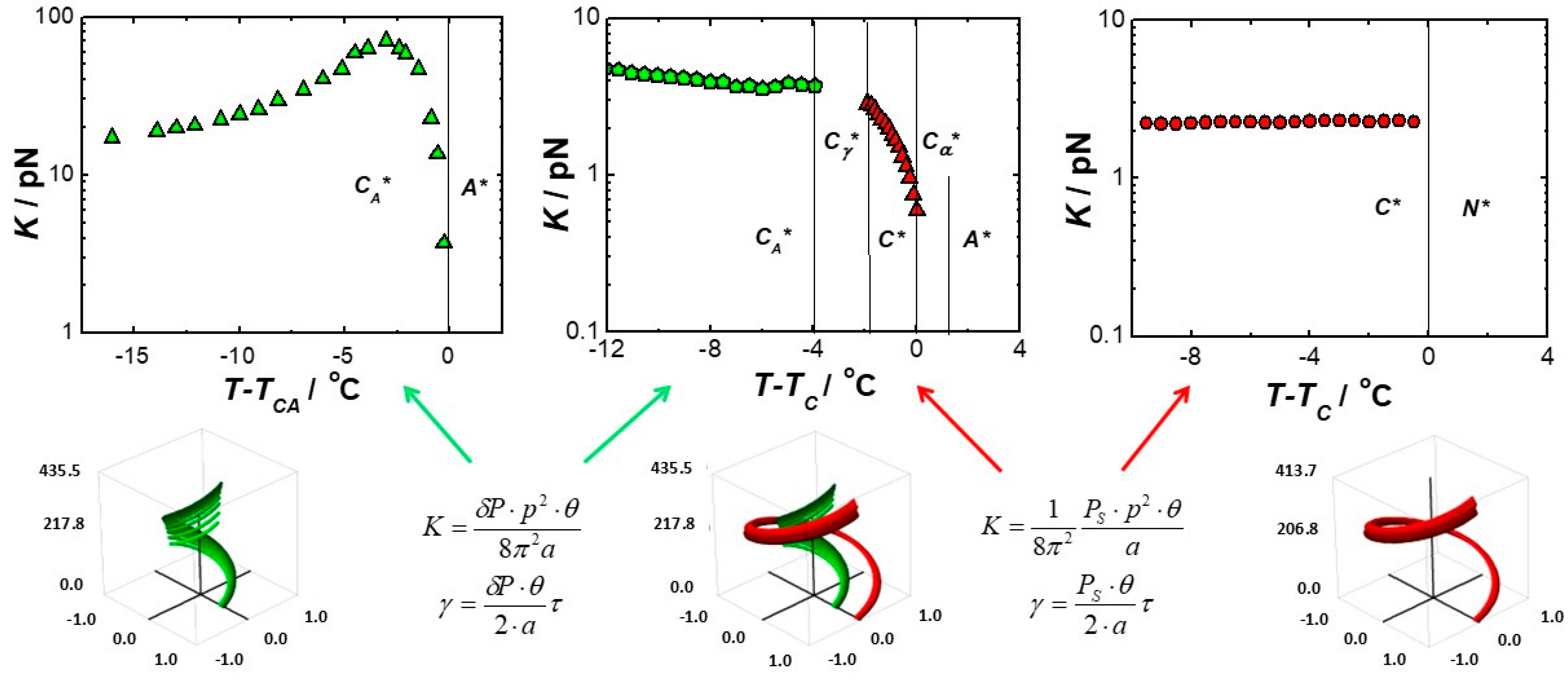
| Detection Method | Voltage Shape | Equation | Literature |
|---|---|---|---|
| Light transmission (switching) | Rectangle | [39,40] | |
| Polarization current | Rectangle | [41] | |
| Triangle | [42] | ||
| Light modulation | Harmonic | [43,44] | |
| Dielectric constant | Harmonic | [21,29] |
| Detection Method | Equation | Literature |
|---|---|---|
| Helix deformation Helix unwinding | [45,46] | |
| Light modulation | [43,44] | |
| Dielectric constant | [47,48] |
| Detection Method | Equation | Literature |
|---|---|---|
| Helix deformation Helix unwinding | [45,46] | |
| Light modulation | [43,44] | |
| Dielectric constant | [47,48] | |
| Light modulation | [65] | |
| Light modulation | [66] | |
| Light modulation | [69] | |
| Light modulation | [71] |
| Detection Method | Voltage Shape | Equation | Literature |
|---|---|---|---|
| Light transmission (switching) | Rectangle | [39,40] | |
| Polarisation current | Rectangle | [41] | |
| Triangle | [42] | ||
| Light modulation | Harmonic | [43,44] | |
| Dielectric constant | Harmonic | [21,29] | |
| Light modulation | Harmonic | [63] | |
| Light modulation | Harmonic | [70] | |
| Light modulation | Harmonic | [71] |
| Short Name | Chemical Structure | Phase Sequence |
|---|---|---|
| C8 |  | Cr 48 (SmIV 12 SmIII 21) SmC* 43.1 SmA* 59 Iso |
| Ce-3 |  | Cr 65 SmC* 77.5 N* 162 Iso |
| Ce-8 |  | Cr 48 SmG 63.3 SmJ 64.7 SmF 66.7 SmI 69 SmC* 85 SmA* 135.4 N* 140.7 BP 141 Iso |
| Ce-3/8 mixture | 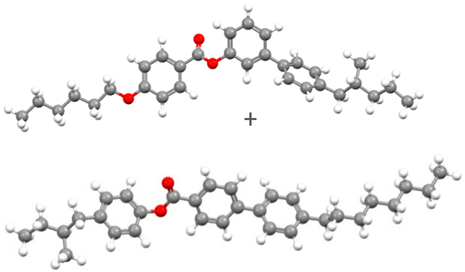 | Cr 39.6 SmG 56 SmJ 65 SmF 67 SmC* 86 SmA*124 N*145.5 BP 147 Iso |
| D12 |  | Cr 111.5 SmCA* 125 SmA* 136 Iso |
| MHPOBC |  | Cr 59.0 SmC*A 119.5 SmC*γ 120.5 SmC*β 121.9 SmC*α 123.0 SmA* 150.2 Iso |
Disclaimer/Publisher’s Note: The statements, opinions and data contained in all publications are solely those of the individual author(s) and contributor(s) and not of MDPI and/or the editor(s). MDPI and/or the editor(s) disclaim responsibility for any injury to people or property resulting from any ideas, methods, instructions or products referred to in the content. |
© 2024 by the author. Licensee MDPI, Basel, Switzerland. This article is an open access article distributed under the terms and conditions of the Creative Commons Attribution (CC BY) license (https://creativecommons.org/licenses/by/4.0/).
Share and Cite
Dardas, D. Survey of Applicable Methods for Determining Viscoelastic Effects in Ferroelectric and Antiferroelectric Chiral Liquid Crystals. Materials 2024, 17, 3993. https://doi.org/10.3390/ma17163993
Dardas D. Survey of Applicable Methods for Determining Viscoelastic Effects in Ferroelectric and Antiferroelectric Chiral Liquid Crystals. Materials. 2024; 17(16):3993. https://doi.org/10.3390/ma17163993
Chicago/Turabian StyleDardas, Dorota. 2024. "Survey of Applicable Methods for Determining Viscoelastic Effects in Ferroelectric and Antiferroelectric Chiral Liquid Crystals" Materials 17, no. 16: 3993. https://doi.org/10.3390/ma17163993






